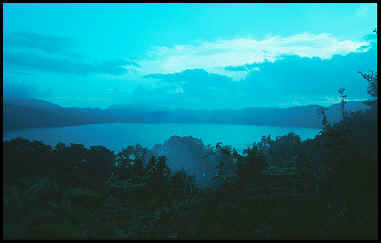Western Cameroon Projects: Mount Oku & Kilum-Ijim
MOUNT OKU including the KILUM-IJIM MOUNTAIN FOREST
- Also see our GIS project for this region
|
Mount Oku lies in the Bamenda Highlands, North West Province and at 3011m is the second highest mountain in west central Africa, after Mt Cameroon (4095m). It contains the Kilum-Ijim Forest, which, at 20,000 hectares is one of the largest remaining patches of Afro-montane forest in West Africa. Population density around the forest is very high with an estimated 250,000 people living within a day's walk, so human pressure on the forest is immense, particularly for new farmland. The Kilum-Ijim Forest Project, a collaborative effort of BirdLife International and the Cameroon Ministry of the Environment and Forestry (MINEF) was established in 1987, to work with communities surrounding the forest to conserve the forest, both for its biodiversity value and for its sustainable use by the local population. |

Lake Oku, at 2200m altitude, contends as the highest crater lake in continental West and Central Africa. The surrounding forest is the most diverse in tree species of all that within the boundary of the Kilum-Ijim Project, including several endangered species, such as Oxyanthus okuensis (Rubiaceae). Lake Oku was proposed as a Plant Life Sanctuary by the Government of Cameroon in 2002, supported by data from our surveys in the area. |
The vegetation changes markedly with altitude, with lower montane forest and savanna and grassland (1500–2000m); Hyparrhenia grassland; waterfalls, rapids, damp shady cliffs and banks (1300–2000m); Lake Oku, a volcanic crater lake (2200m); grassland swamps (1750–2800m); upper montane forest (2000–3000m) and upper montane grassland (2800–3011m).
| Kew projects
Since 1996, at the invitation of BirdLife, RBG Kew has been conducting botanical inventories in an area of c. 1500 square kilometres on and around the mountain, at altitudes from 1200m up to the summit. The most comprehensive plant species list pre-1996 listed 91 taxa (Thomas, 1986). Cheek, Onana & Pollard (2000) increased this figure to 920 with the publication of their comprehensive Conservation Checklist. Also there is a GIS project for this region looking at the change in vegetation over the years. |

Part of the 1996 botanical inventory team above the tree line on Mt Oku. Left to right: Anne Dillen (Earthwatch Volunteer), Dr Benoit Satabie, Jean Michel Onana and Fulbert Tadjouteu (National Herbarium of Cameroon), Felix Bafon and Peter Wambeng (guides from the Kilum Project). |
|
New and threatened species Newtonia camerunensis Several collections represented species new to science, some of which have since been described and published (eg. Phillips, S.M., 1998 & 2000; Cheek & Csiba, 2000; Cheek & Sonké, 2000). References Cheek, M. & Csiba, L. (2000). A new species and new combination in Chassalia (Rubiaceae) of western Cameroon. Kew Bull. 55: 883 - 888. Cheek, M. & Sonké, B. A new species of Oxyanthus (Rubiaceae-Gardeniinae) from western Cameroon. Kew Bull. 55: 889 - 893. Phillips, S.M. (1998). Two new species of Eriocaulon from West Africa. KewBull. 53: 943 – 948. Phillips, S.M. (2000). Two more new species of Eriocaulon from West Africa. Kew Bull. 55: 195 – 202. Cheek, M., Onana, J.-M. & Pollard, B.J. (2000). The Plants of Mount Oku and the Ijim Ridge, a Conservation Checklist. iv + 211 pp. RBG, Kew. Thomas, D.W. (1986). Provisional species list for Mount Oku flora, pp. 59–62 in McLeod, H.L. (1986). The Conservation of Oku Mountain Forest, Cameroon. Study Report No. 15. 90 pp. ICBP. |

